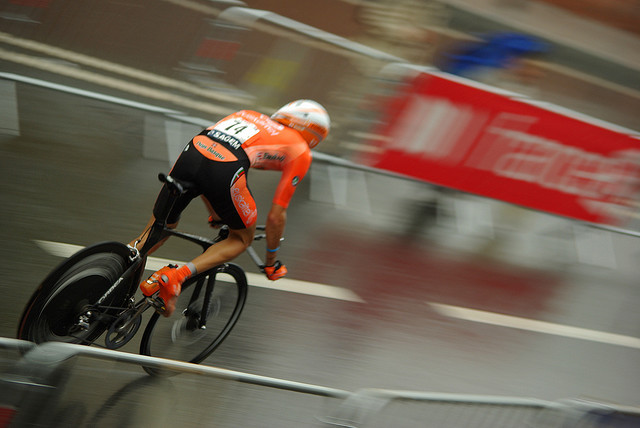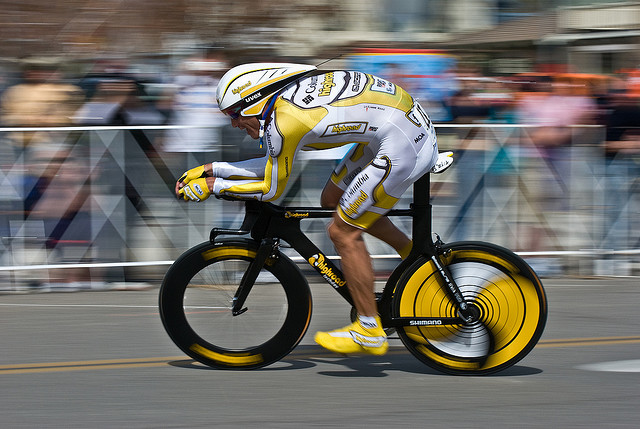What’s a better cross training exercise for runners, cycling on the road or spinning?

Runners are always looking for ways to get in better shape. When I was in college, I got a Trek road bike to stay fit when I was injured and to add some extra non-impact exercise to my summer training.
It was a blast: flying downhill at 35+ mph and seeing how fast I could go on flat stretches was exhilarating. When I got a heart rate monitor, I strapped it on during a bike ride and found that my effort level was all over the place. My heart rate was essentially at the whim of the road.
Then I measured my HR on a stationary bike at the gym and it was incredibly even. But I hated the stationary bike (still do) even though I could better control the workout.
How do you choose between cycling or spinning when both are so different?
Cross Training for Runners
First, let’s talk about why runners should even think about cycling in the first place. Whether you hop on a road bike or a fitness bike at your gym, both are non-impact cross training exercises that help build your engine – your lungs, capillary network, and heart strength. You can keep off unwanted pounds and maintain a pretty good fitness baseline even if you’re just cycling.
Of course, cycling isn’t the only form of cross training for runners. Pool running is your other top choice, but let’s stay on topic here.
When added to your running plan, cycling is a great way to add extra fitness with virtually zero injury risk. I’ve written before about my experience with triathlon training and how it helped me elevate my running to a new level. Cycling can give your performances a big boost by further developing your aerobic system.
If you add a lot of biking to your weekly workouts or replace a few runs with bike sessions, keep these pointers in mind:
- Maintain your long run and quality running workout. Replace your maintenance runs (if you’re replacing any runs).
- Strength exercises are vital, even for your legs. Cycling is zero-impact and doesn’t keep your bones strong like running does.
- Keep your running cadence at about 90+ RPMs (rotations per minute). This will help mimic a running stride.
If you’re replacing a running session with a cycling workout, here’s an extremely scientific (wink) conversion: 10-15 minutes on the bike is about the equivalent of one running mile. This will help you maintain the same level of fitness while on the bike.
Road vs. Gym Cycling
Both biking on the road and joining a spinning class can give you a great cardiovascular workout. But they’re different, so let’s talk about the advantages and disadvantages of each.
Spinning gives you a much more controlled workout. With no up or downhills, you can more accurately control your level of effort. There’s also no risk of crashing, something that I’m all too familiar with after I ripped up my leg during a crash a few years ago.
While you can control your heart rate and cadence better on a stationary bike, it’s boring as hell. Maybe it’s me – and I’m admittedly biased because I have the attention span of a dog in a squirrel park – but ten minutes on a bike at the gym feels like a two hour run. I highly recommend wearing your iPod and putting together a great playlist.
This is why I prefer road cycling – it’s just more fun! You can fly down hills, coast when you want to, and hit the hills hard if you’re in the mood. But due to the nature of the terrain you’re riding on, you’re less able to control your level of effort; the road dictates it for you. Both your heart rate and your cadence will partly depend on the terrain.
Being out on the road is also more stressful as you navigate busy streets, cars, pedestrians, stop lights, and other cyclists. The risk of crashing is real, so pay attention and don’t take unnecessary risks.
You may have noticed I haven’t even mentioned mountain biking. If you’re serious about running or just want to stay healthy, I’d recommend you stay off the trails. A lot of runners get hurt falling off their bike on the trails so I don’t suggest mountain biking for injury risk reasons. I’d rather see you healthy.
My Favorite Bike Workouts

Road cycling and spinning require different workouts. It would be too hard to do a long tempo workout on a road bike if you live in a hilly area, for example. Here are two workouts I’ve done in the gym and on the road that I love.
Road bike workout: I love fartlek workouts and running on feel, so I do similar workouts on my bike. Even if your area is hilly or flat, you can ride the terrain and get in a solid workout. For me, I ride moderate up hills, go easy on flats, and sprint the downhills. I don’t do this on every single hill or flat section, but I love going fast so this is a frequent workout.
If you live in the middle of Kansas where the biggest downhill is a pot hole, this type of workout may be challenging. I’ve done similar workouts but with time intervals instead:
- 15 minutes easy to warm up
- 10 minutes moderate
- 1 minute sprint
- 10 minutes moderate
- 1 minute sprint
- 15 minute easy warm down
Spinning workout: Here you don’t have to worry about anything except how much resistance you’re putting on your bike. Stationary bikes lend themselves to more structured workouts based on time rather than fartleks based on landmarks or terrain. Since I hate stationary bikes and prefer to keep things short, this is my favorite 30 minute workout:
- 10 minute warm up
- 5 x 2 minutes at 5k effort with 30 seconds easy recovery
- Warm down to 30 minutes total
Gear You Don’t Need
Besides a bike and a helmet, there’s not much gear you need to get in a good cycling workout on the roads. And if you’re going to the gym, you barely need anything! My only recommendation for spinning workouts is a good playlist to get over the boredom of spinning in place.
You can also check out our Running Deals page!
Hitting the road is a different story. You’ll need the basics: a bike, helmet, and working brakes. Otherwise, you can get by with nothing else. But there are some things that will make cycling more enjoyable and safer.
- Get ID and carry it with you. I never ride without mine – just in case there’s a crash, you want first responders to have the information they need to potentially save your life.
- Use a BPA-free water bottle to stay hydrated in warmer temperatures. My favorite cycling beverage: chilled green tea with honey.
- Cycling shorts with a chamois. Guy or girl, you want some padding for your butt. I tried using just running shorts and I was sore for days. Learn from my mistake…
- Bike computer. These can be fairly cheap and they’re highly recommended for the data nerds out there. You’ll be able to track top speed, average speed, total distance, and time (among a million other things).
If you need a place to store some cash, your phone, or some gels get a cycling jersey with rear pockets. I highly recommend this one.
Just Get it Done
There’s no right or wrong answer to which type of cycling is the best form of cross training for runners. The most important factor is actually getting in the workout – so if you’re more likely to do that on your road bike because it’s more enjoyable, then do that. But if you don’t have a road bike and the gym is more convenient, do that!
Both offer a way to get in a great cardiovascular workout without putting additional impact stress on your legs. Use them the same way you would a pool running workout: easy and light to promote recovery and moderate to increase your endurance.
For those who are prone to running injuries, cycling is excellent cross training for runners!
Stay safe out there.